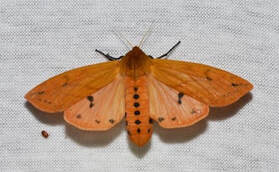CONSERVATION CORNER
A weekly blog for all things conservation
 By Ryan Reed: A reprint from Forest Fridays- A DCNR publication. My first memories of woolly bears come from childhood, when a friend and I began capturing as many furry caterpillars as we could find one fall. Some of them were tan, some white; others were completely black, or brown and black. We caught a lot of flak from my friend’s dad when we released them all into his sunporch. I didn’t know it at the time, but the black and brown ones were woolly bears (Pyrrharctia isabella), which I gradually came to view as symbols of fall and harbingers of winter. I’m fairly certain it was my grandmother who first told me that the blacker the woolly bear, the harder the winter will be. She and my grandfather seemed to always have a wives tale for any occasion, one that typically started with, “they say…” . Digging into woolly bear colors and winter severity correlation, it was surprising to learn that this has actually been scientifically studied. Although the 1948 study in New York did little to lend credibility to the purported relationship between woolly darkness and winter cold, it did oddly lead to more publicity for this bit of folklore, and perhaps helped elicit its tacit approval as a rule of thumb.
Although there doesn’t appear to be any scientific validity to woolly bear morphology and influence on winter, these insects are still quite the scientific wonder. Woolly bears are the larval stage of the Isabella tiger moth, a ubiquitous inhabitant of an enormous range spanning northern Mexico, the US, and most of Canada. Their biological capabilities seem to extend into the realm of the supernatural, surviving being frozen in ice and withstanding temperatures as low as negative 90 degrees, Fahrenheit! One may wonder how this is possible, but something happens just before hibernation (yes, you could say that we have two “bears” that hibernate in PA!). As the woolly bear settles into a cool, dark place before winter, its internal tissues exude glycerol, a natural antifreeze, which keeps it from freezing solid. Amazingly, woolly bears can repeat this annual process up to a reported 14 times before their development is complete. Woolly bears residing in the species’ more northerly range take longer to develop due to shorter growing season, so a woolly bear encountered in Canada could be much older than we might think. Once its caterpillar stage is complete, the woolly bear metamorphoses into an adult Isabella tiger moth, as seen below. Just in case you’re wondering, I’ve seen quite a few woolly bear caterpillars this early fall, and their colors have been remarkably variable, so this winter will be anything between mild to severe (you’re welcome!). If you’re a fan of the woolly bear, you’ll be interested to learn that Pennsylvania celebrates this critter in at least two annual festivals in Lewisburg and Oil City. Learn more about the woolly bear here: https://www.weather.gov/arx/woollybear /
0 Comments
Leave a Reply. |
AuthorsVarious staff at the Bradford County Conservation District Archives
July 2024
Categories
All
|
|
Bradford County Conservation District
Stoll Natural Resource Center 200 Lake Road, Suite E | Towanda PA 18848 Phone: (570)-485-3144 |
